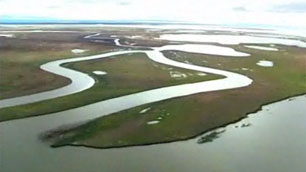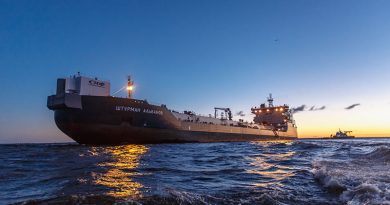Russian VTB bank to finance the construction of icebreakers

By Elizaveta Vereykina, The Independent Barents Observer
Amid sanctions, the importance of the Northern Sea Route rises.
The Russian-sanctioned bank VTB has signed an agreement with the state-owned company Rosatom. According to the agreement, the VTB bank will finance the construction of 3d and 4th ice breakers for the Northern Sea Route (The NSR) that runs from Murmansk eastwards to the Bering Strait near Alaska.
The goal is, as the Rosatom describes on its website, “to make the Northern Sea Route an effective transport artery linking Europe, Russia, and the Asia-Pacific region”.
Earlier this month, as Reuters reported, a Kremlin aide urged the Russian government to adopt legislation allowing foreign-flagged vessels to use the NSR.
Importance of Northern Sea Route
The importance of the Northern Sea Route is rising as Russian presence in the Arctic is seen as one of the main strategies to evade sanctions imposed by the US and EU following Russia’s invasion of Ukraine on February 24, 2022.
Earlier in May this year the head of Rosatom Alexey Likhachev said that the company had been working on a plan to redirect oil from the Baltic ports to head eastwards via the Northern Sea Route, after Europe’s decision to ban Russian oil imports as the result of Russia’s invasion of Ukraine.
“We have been left without transit routes, – Igor Levitin, a former Russian transport minister and an aide to President Putin, said at the St Petersburg economic forum in June this year. – The Northern Sea Route is a new challenge to international logistics”.
As climate change slowly melts the Arctic sea ice, the NSR opens lots of possibilities for shorter transportation routes between Asia and Europe.
The ice breakers that Rosatom is constructing, are able to break through ice up to 3 meters thick. One of the purposes of the NSR, as Rosatom reports, is to “ensure the escort of vessels with hydrocarbon raw materials from the fields of the Yamal and Gydan Peninsulas to the markets of the countries of the Asia-Pacific region”.
Construction in St -Petersburg
The ice breakers will be constructed at the Baltiysky factory in St Petersburg – one of the oldest Russian shipyards, founded in 1856.
Besides controlling Russia’s ice breaker fleet, the state-owned company Rosatom is a crucial component of Russia’s military-industrial complex, including the production of Russian nuclear weapons and nuclear fuel.
In June this year, President Putin confirmed the Russian tactical nuclear warheads have already been delivered to Belarus and hinted the weapon could potentially be used: “…It is precise as an element of deterrence so that all those who are thinking about inflicting a strategic defeat on us are not oblivious to this circumstance,”Putin said.
Related stories from around the North:
Antarctica: AI tool developed for polar shipping to help vessels reduce emissions, Eye on the Arctic
Canada: Qanittaq Clean Arctic Shipping Initiative gets $91.6 million from Ottawa, Eye on the Arctic
Denmark/Greenland: New guideline launched for Arctic-specific risk assessment in shipping, Eye on the Arctic
Finland: Finland’s aging icebreaker fleet needs modernization, Yle News
Iceland: Int’l Arctic emergency marine exercise will lead to better response coordination, say participants, Eye on the Arctic
Norway: The Viking Sky incident – A wake-up call for the Arctic cruise industry?, Eye on the Arctic
Russia: Ice conditions on Northern Sea Route may pose navigation challenges this season, The Independent Barents Observer
United States: ‘Uber for icebreakers’ idea gains traction in U.S. Senate, Alaska Public Media



